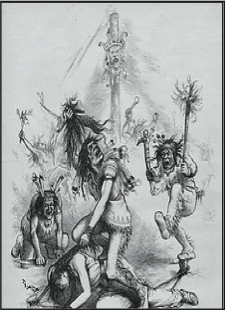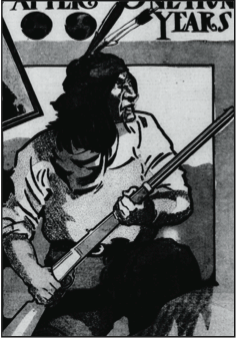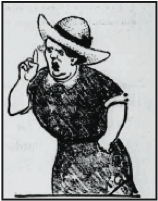From Elon Journal of Undergraduate Research in Communications VOL. 4 NO. 1Visual Persuasion: The Media's Use of Images in Framing People Groups
IN THIS ARTICLE
AbstractThis article compares the media's framing of five groups in response to a societal catalyst that propelled them into the public and media spotlight: Native Americans during the Indian Wars; women during the suffrage movement; African Americans during the Civil Rights Movement; Japanese Americans following the attacks on Pearl Harbor; and Muslim Americans after 9/11. A tipping point forced each group outside the "status quo," leading to pointed and biased coverage, usually in conjunction with dominant prejudices of the era, with the goal of protecting the ruling majority. While the target may have changed, the media have advanced little, during the past century, in their treatment of groups outside the traditionally understood American identity. Methodology used in this study includes analysis of print reports from multiple media outlets, including both text and visuals, to identify framing techniques, as well as study of secondary sources to provide historical context. I. Introduction In May 1963, the same image was featured within the pages of four national news publications, including The New York Times, Time, Newsweek, and Life. The photograph, shot by Bill Hudson with the Associated Press, showed a meek and seemingly harmless African American man being held by a police officer while a dog lunged at the young man's stomach. The image came to define the heart of the Civil Rights Movement and the fight waged by African Americans in their quest for equal rights. While the target may have changed, the media's use of images, such as Hudson's, in framing the debate about current events has not altered significantly since the start of the 20th century. Specifically, the press' treatment of groups considered threats to the "status quo" has, in most cases, assumed a biased and negative tone. Some examples of mainstream press calls for less biased treatment of these groups occurred, but they were greatly outweighed. While numerous groups were targeted by both the public sphere and the press throughout the past century or more, five specific groups stand out in the similarities of their treatment: Native Americans during the American Indian Wars (1811-1923); women during the suffrage movement; African Americans during the Civil Rights Movement; Japanese Americans following the attacks on Pearl Harbor; and Muslim Americans following the 9/11 attacks. At each significant point in America's history, these groups were framed as a threat to the norm, or the traditional American identity. As a result, the press frequently used exaggerated photographs and twisted editorial cartoons to dictate how the public should view them and, in some cases, encouraged action against them. Sometimes, the group appeared innocuous and in others as threatening. But no matter which direction the media frame tilted, one commonality remained: When in the crosshairs of the media, the people group was not the norm and was, rather, categorized as "the other." II. Framing as TheorySince the creation of the printing press and the ability to distribute news and information on a mass scale, the media have been used as a tool through which to promote not only the reports of the day, but the way the public should view them. In some cases, this comes as a result of inherent prejudices or weaknesses in the practices of the organization. In other instances, it is founded in the reliance of the press on biased sources with underlying motives. This construction of public perception, using tools such as language, style, structure, and images, is referred to as framing and can seriously influence not only the audience's understanding, but public policy as well. While the information itself may be factual, the reporting style advanced by the media can have definite effects on the reader's perception: "The effect of this framing can be far more powerful than the opinions expressed in editorial columns. Media framing affects government decision-making both directly, by supplying information to decision makers, and indirectly, through public opinion."1 Expert Robert Entman describes framing as "the process of culling a few elements of perceived reality and assembling a narrative that highlights connections among them to promote a particular interpretation."2 Essentially, according to his analysis, framing is the process of raising the salience or perceived significance of particular ideas, characteristics, or events that, most importantly, works to slant the audience toward a particular way of thinking. Various explanations have been provided as to the actual tactics used by the media to promote a particular frame – or, in other words, how the audience is led to think in this particular way. And while most stories will not contain all of these elements, they form the broadly based foundation for constructing a frame. According to research by Pan and Kosicki, there are four primary structural dimensions of news: (1) syntactic structures, or how words or phrases are placed; (2) script structures, or the perceived newsworthiness of the event; (3) thematic structures, or the use of causal statements to emphasize blame; and (4) rhetorical structures, or the stylistic choices made by journalists.3 Entman explained that the foundation of framing lies in the selection and salience emphasized by journalists: "to frame is to select some aspects of a perceived reality and make them more salient in a communicating text, in such a way as to promote a particular definition, causal interpretation, moral evaluation, and/or treatment recommendation."4 He also identified five media traits that can create a frame of reference: (1) importance judgments; (2) agency, or answer to the question (such as, who did it?); (3) identification of potential victims; (4) categorization or choice of labels; and (5) generalization to a broader context.5 It has been established within the study of journalism that "issues the news media set up as important will be considered to be important by the public, and media thus set the agenda for public discussion."6 After defining the problems worthy of the public's attention, and spotlighting particular events or traits, the media can then promote their own spin on the story.7 While not always deliberate, this sense of orchestration of information and style at the hands of journalists contributes to the operations of democracy, a critical component of the media when facilitating engagement with society.8 Framing occurs both organically and purposefully. In some cases, it is the result of a media group's weak organizational skills that result in poor writing and editing skills − usually the organization is unaware of how their work is being affected by deadlines or enforced protocols.9 But, more often than not, framing is a deliberate, active process that comes as a result of the media's inherent limitations and prejudices. Perhaps one of the most powerful of these confines is the tendency of the press to be biased toward the status quo: "[objectivity in journalism] is inherently conservative to the extent that it encourages reporters to rely on… the 'managers of the status quo' – the prominent and the elite."10 Often, elite, white, males serve as the key sources for quotes, insight, analysis, and basic information, meaning the media often serve as the conduits for the promotion of a certain perspective to an audience.11 Beyond the elite, the press is often tied as well with the state, relying on information provided by the government to construct their stories. But, as much as journalists are influenced by their sources, the target audience also drives their content. Most news organizations seek audiences that are affluent, those being most preferred by advertisers, on which media outlets rely heavily.12 As a result of this pandering to the well-off, educated, and urban, certain classes are inherently ignored: "The majority – the poor and disadvantaged – have little or no access to the mode of engaged citizenship such media can offer."13 Framing has been criticized by some as a convenient tool in the pocket of a biased media system and praised by others as a means of quickly and easily explaining a dense or expansive topic. Yet a conundrum still remains: "for a rationally debating public to come into being, a high degree of orchestration is needed. However, with orchestration comes control – control over the dynamics of debate, over the issues and voices, and over who gets to be a part of a public and who is excluded."14 Ideally, frames are intended to be prescribed to certain topics as a means through which to give meaning and an organizing idea or story line to an event being covered by a journalist. But it is when these tendencies are coupled with a tense sociopolitical climate that the dangers of framing become most apparent. Frequently, frames reflect shared cultural narratives and social themes to which journalists are acutely sensitive: "In the great blooming, buzzing confusion of the outer world we pick out what our culture has already defined for us, and we tend to perceive that which we have picked out in the form stereotypes for us by our culture."15 Often, this equates to the marginalization of sociocultural, religious, and other groups considered outside the norm through "misinformation, racist ridicule, and overall unfair coverage."16 And, in many cases, the press simply reflects the prevailing public sentiment of the time: "[Established] general circulation newspapers have tended to go along with efforts to suppress deviations from the prevailing political and social orthodoxies of their time and place, rather than support the right to dissent."17 III. Existing LiteratureWhile the use of media framing has been prevalent for centuries, it was only more recently that the tactics employed by journalists have come under the close scrutiny of researchers. Around the turn of the 20th century, fear of the effect of media messages on attitudes first began to grow as strategic propaganda dominated the experiences of much of the developed world during World War I. Studies of framing progressed through different stages during subsequent years. From the 1930s to the 1960s, much emphasis was placed on the idea of personal preference and the fact that the media simply reinforced existing ideas, followed by a brief period of focus on the cognitive effects of the media. The most current understanding is that of the idea of "social constructivism" by which the "mass media actively set the frames of reference that readers or viewers use to interpret and discuss public events."18 Works including Mightier than the Sword: How the News Media Have Shaped American History by George Streitmatter and News for All the People: The Epic Story of Race and the American Media by Juan Gonzalez and Joseph Torres have examined the intersection between framing and the public's perception. However, this study is unique in that it draws comparisons between five groups of a people in a way that has never previously been done, concluding that the press has historically set its crosshairs on a group of people and attempted to portray them as "the other" when they posed a threat. The study draws primarily upon print visuals (both in newspapers and as stand alone images, such as propaganda) from each time period, while also incorporating written text to support and bolster the argument made by the images.Continued on Next Page » Suggested Reading from Inquiries Journal
Inquiries Journal provides undergraduate and graduate students around the world a platform for the wide dissemination of academic work over a range of core disciplines. Representing the work of students from hundreds of institutions around the globe, Inquiries Journal's large database of academic articles is completely free. Learn more | Blog | Submit Latest in Business & Communications |


































